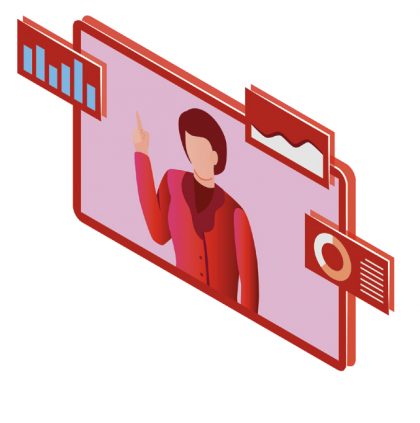Currently it’s Corona, but in previous times travel bans due to cost-cuttings or other reasons already made way for communication going more digital.
“How can we communicate and stay in touch nowadays?” is again a very frequently asked question. Doing a Webinar, using Skype, Zoom, Teams, Jitsi, Tox, Viber, Facebook or WhatsApp or another service for internet-based chats can never replace any personal encounter, but at least complement it.
Andy Warhol predicted in 1968 that everybody would be famous for 15 minutes in the future.
That future is now, and with the little tips and tricks below you may stay famed for an even longer time!

Before – Ask yourself
1
What do I want to achieve by getting in touch? Just a brief “hello, how are you?” or discussing a difficult matter? Doing a training- session of some sort? What’s your agenda?
2
What do I want to show? Just my face or also documents, slides or anything else?
3
Does my dialogue partner have internet? A computer or mobile phone with a camera? The video chat service I am intending
to use? Is he or she comfortable using it, too?
4
Would a friendly phone call, combined or followed up by mail, achieve the same goal? Mail and phone shouldn’t be abandoned just because there’s video chat now. Instead of trying to kill it all with one tool “webinar”, choose and mix.
Stage fright sets it right
Professional actors and speakers will reassure you that a little stage fright is perfectly normal. Putting your own stage under scrutiny is a must in order not to have it frighten your audiences. Or into a laughing fit. Or secretly hobby psychoanalyzing you – by the heaps of ironing work, pattern of the wall paper or book shelves in silent suffering far beyond heavy- duty in your background.
You yourself will be on camera, all right. But where exactly will you be and what else will be visible with and around you? Test upfront how you come across on camera with a good friend. Or place a mirror at some distance and look at yourself. Stand up and look at your stage without yourself in it.
If you don’t like it but don’t own a folding screen and if there’s also no way to hang up a bed cloth or a cover: Some video chats, like Zoom for example, offer virtual backgrounds, in case you don’t want to show your authentic living space to anyone because of mountain massifs of ironing work, debatable interior designs or heavy metal posters covering each black painted wall.
Dress for success
Pick your outfit with care, especially when you’re working from home. Because you’re attending a business-meeting, only that it takes place online. You want to dress like you’re attending a business meeting.
At least the visible upper part of your body wants to. Business casual is probably what you’d also be wearing in the office, and that’ll do most of the time. But for more formal meetings: formal attire.
Get the light right
Light alone is an epic topic. Professional actors have light stand-ins, some insist on getting particularly lighted in their movie contracts. Good lighting is as important as make-up, in fact even more.
If you find this hard to believe: Take a flashlight, stand in front of your mirror, switch the room lights out and your flashlight on. Now light yourself from below, slightly under your chin. Probably you are blessed with divine beauty and don’t understand this experiment.
However, if your beauty is more of earthly nature: Try lighting yourself from slightly in front and above your forehead.
While on camera you may want to have a reading light nearby. Or you may want to position yourself in a way you have good light onto your face – test it on camera or with the help of a mirror. Avoid any bright light in your back, e.g. from windows, chandeliers or else, because it takes away from your face and reduces you to a shadowy lump in front of the screen.
Immediate lifting without scalpel
If your camera is below your eye-level because you’re using a laptop with the screen slightly angled and your double chin, flabby cheeks, lacrimae and vibrissae (lat. for tear sacs and the hairs in the nose) threaten to outact you singlehandedly or as an ensemble: Give your gadget greater height by placing it on a box or some books.
Avoid sprawling yourself into your seat like a cheese painted by Dali. Stay aware of yourself especially when you may not be presenting but only listening.
Mind your face: grimacing or sleeping awake is always on air now. You also want to avoid eating, at least heavier meals, not to mention nose or ear picking. Because we can all SEEEEEEEE you!
Sounds good?
In a one-on-one setting you probably know your dialogue partner already and speak the same mother tongue. Your conversation will feel and sound familiar.
In a bigger round with more people attending: Try to talk slowly and clearly. Local accents are beautiful but often hard to understand. Pace yourself well, make breaks more frequently, make sure people understood what you said. Give them smaller chunks of information, verbally and on slides, if you show any.
Ask, if there are questions or opinions or prepare people upfront that you are happy to take questions at the end of your presentation.
Especially with more attendees to your webinar or video chat you may want to all mute your microphones when you’re not talking. It cuts out noise and helps to stick to one person speaking at a time. Gently mute your mobile phone, pets, family members, if possible, for the duration of the meeting – or prepare attendants upfront that you may get called and ask their understanding.
Also be aware of other tonal expressions your own body may be making: Head scratching, finger tapping, belching, snorting… you get the idea! Remember muting your microphone or closing your doors when taking a bio break or using the espresso machine, and not just because your audience may not be able to tell which is which.
Try to talk slowly and clearly. Local accents are beautiful but often hard to understand

Speaking of which: plan for short breaks in longer webinars
Try to keep meeting time rather shorter than longer and allow for breaks in between if you need longer meetings. Standing up, stretching, using the restroom or fetching a snack can help refresh attention. Announce breaks upfront and stick to the times.
Dry run
If you plan a bigger project, not just a video chat, and feel doubtful or unexperienced: Practice. With friends or if they are to be your very audience to be surprised, use sofa cushions as a great, forgiving, a very patient audience until you can pull it off well. You can also talk against a wall or memorize your piece on a long walk outside with your dog.
Do whatever helps to internalize what you like to convey. Not necessarily word by word, but in terms of bigger picture. Depending on content, you may also need to truly read things out loud to your audience.
If so, remember to look up every now and then.
Eye contact
When presenting: Try to talk through the screen as if to a real person or a real audience, which in fact, you do because your audience is super real.
Try to maintain eye contact at least every now and then. This is the hard part because you need to look into the faceless “eye” of the camera and the actual eye contact is both illusion (for you) and real (for your counterpart).
Keeping eye contact gets easier when you are away from the camera, for example, sofa2sofa video chats (but no sprawling, remember?).
Ready to step into the web – Invite and involve
Send a friendly text briefly stating name and purpose of your meeting, link or name to video services used, duration, agenda. If there are more than two or three attendants, also state the other participants – if somebody else than you – is hosting of meeting, dial in details, contact for questions.
Involve your dialogue partners or your audience depending on the size of your round, of course. Ask for feedback, opinions or other contributions. Wrap up and thank everybody.
After the webinar, follow up with some materials, for example the slides you have presented, an opinion poll or a task or homework exercise for the attendees to accomplish.
Maybe assign someone from your audience to set up the next video chat or webinar or with announcing your next being on-air again. In any way, follow up with a little “Thanks for being there” note.

